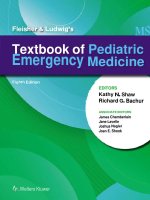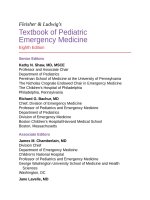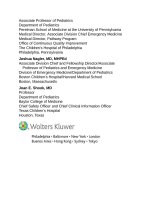Pediatric emergency medicine trisk 1489 1489
Bạn đang xem bản rút gọn của tài liệu. Xem và tải ngay bản đầy đủ của tài liệu tại đây (100.07 KB, 1 trang )
Stridor With Acute Onset in the Febrile Child
Laryngotracheitis (croup) is by far the most common cause of stridor in the
febrile child. Other diagnoses that should be considered include bacterial
tracheitis, epiglottitis, and much less commonly retropharyngeal abscess or
laryngeal diphtheria in the unimmunized child (see Chapter 94 Infectious Disease
Emergencies ). Though less common than croup, these diseases have a greater
potential for life-threatening airway compromise.
Croup most commonly affects children between 6 and 36 months of age with
peak incidence around 2 years of age but can be seen throughout childhood. It is
the most common cause of upper airway obstruction in children in this age group.
Croup typically begins with symptoms of an upper respiratory tract infection and
fever, usually ranging from 38° to 39°C (100.4° to 102.2°F). Within 12 to 48
hours, a barky, “seal-like” cough and inspiratory stridor are noted. The stridor is
worsened when the child is agitated and often improves with nebulized racemic
epinephrine. Supraclavicular and subcostal retractions may be present. Most
children appear mildly to moderately ill, though the loud breathing and
respiratory distress can be alarming to family members.
Bacterial tracheitis has a varied presentation but can resemble croup. Patients
tend to be older, appear more toxic, and may not improve as much as expected
with nebulized racemic epinephrine. Dysphagia is common, and drooling may be
present. The verbal child may complain of anterior neck pain or a painful cough.
Epiglottitis is an infection of the supraglottic structures, and therefore often
called supraglottitis. Historically, epiglottitis was most commonly caused by
Haemophilus influenzae type B. Other causative pathogens include
Staphylococcus aureus, Streptococcus pneumoniae, β-hemolytic streptococci, and
viral agents (parainfluenza, HSV 1, and varicella). Noninfectious causes can
include direct trauma and thermal injury. The incidence of epiglottitis due to H.
influenzae has plummeted to as low as 0.02 per 100,000 in Western countries
following the introduction of the conjugate vaccine. Sporadic cases are seen in
unimmunized children or vaccine failures. Patients with H. influenzae epiglottitis
typically appear toxic with fever and drooling. Respiratory distress and a tripod
stance (i.e., upright position, neck extended, and mouth open) are characteristic
symptoms. Sudden airway compromise may occur and can be precipitated by the
manipulation of the oropharynx.
In contrast, epiglottitis caused by pathogens other than H. influenzae has a
more insidious onset, is more common in older children and adults, and is almost
universally associated with dysphagia or sore throat. Importantly, there is less risk
of airway compromise with this presentation. However, any child with suspected









